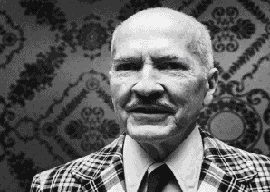
March 30, 2011

Robert A. Heinlein
The rise of the nerds to mainstream dominance is one of popular culture’s most important developments over the last generation. Consider the gulf in sensibility between old Hollywood blockbusters such as Gone with the Wind and characteristic 21st-century tent poles such as Avatar, Lord of the Rings, and The Dark Knight.
A central figure in the evolution of obsessive geeks into a self-aware, self-confident community was science-fiction author Robert A. Heinlein (1907-1988). For many of the mid-20th century’s lonely youths, discovering Heinlein stories in pulp sci-fi magazines or at the public library was a you-are-not-alone moment.
Yet a massive new Heinlein biography by William H. Patterson, Jr. illustrates a paradox: Heinlein himself wasn”t a nerd. Weighing in at 624 fact-crammed pages, Robert A. Heinlein: In Dialogue with His Century: Volume I, 1907-1948: Learning Curve> (whew…) is redolent of the Aspergery culture that Heinlein helped call forth. Patterson can”t bear to leave out data about Heinlein’s well-documented life. The book winds up too much of a good thing for all but the most compulsive of us Heinlein geeks.
Ironically, the urbane Heinlein preached the virtues of being an all-arounder. He famously proclaimed:
A human being should be able to change a diaper, plan an invasion, butcher a hog, conn a ship, design a building, write a sonnet, balance accounts, build a wall, set a bone, comfort the dying, take orders, give orders, cooperate, act alone, solve equations, analyze a new problem, pitch manure, program a computer, cook a tasty meal, fight efficiently, die gallantly.
In truth, Heinlein wasn”t hugely successful at anything other than writing science fiction. Yet his resume of near misses during the decade before he started writing sci-fi gave his books a texture and realism surprising in a genre aimed at unworldly youths. He had been a naval officer on the world’s largest aircraft carrier, a Greenwich Village bohemian artist, a silver-mine owner as the front man for the Pendergast Kansas City political machine, and a crusading left-wing politician.
Heinlein’s life story, beginning with lower-middle-class poverty, is similar to that of his idol, H. G. Wells, the pioneering science-fiction novelist. Wells, however, was a giant figure in early 20th-century culture, while Heinlein’s renown was narrower. That sort of ghettoization is ongoing. Andy Warhol is still famous for saying 43 years ago that in the future everyone will be famous for 15 minutes. It’s more likely that in the future everyone will be famous to 15 people.